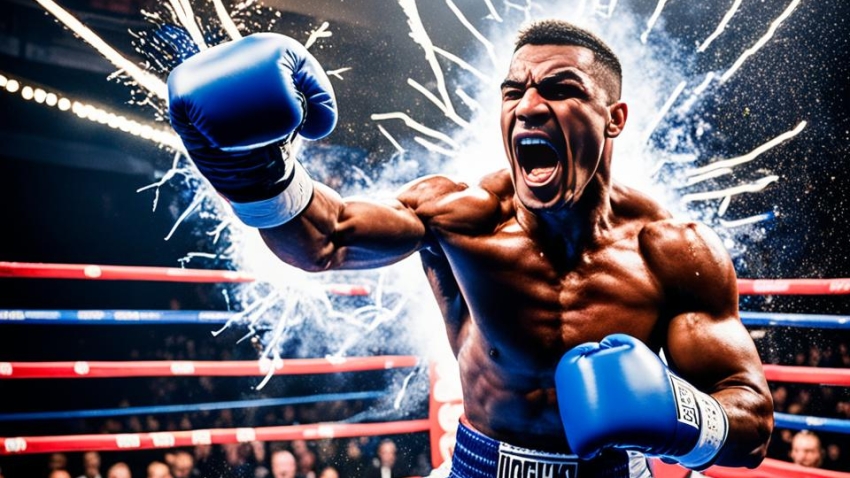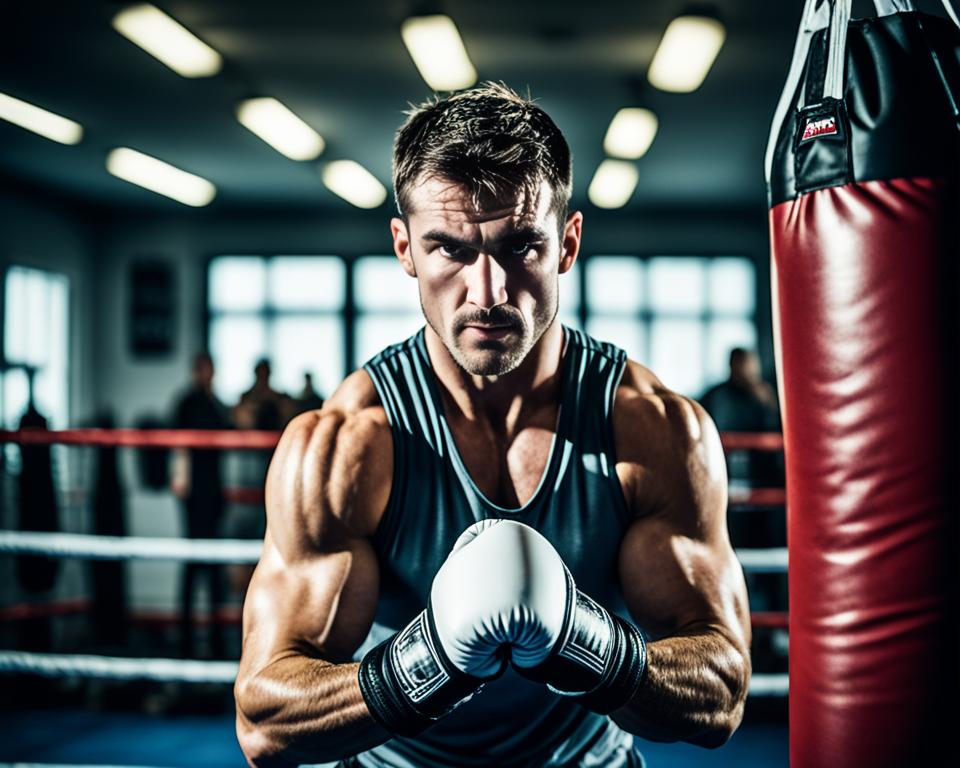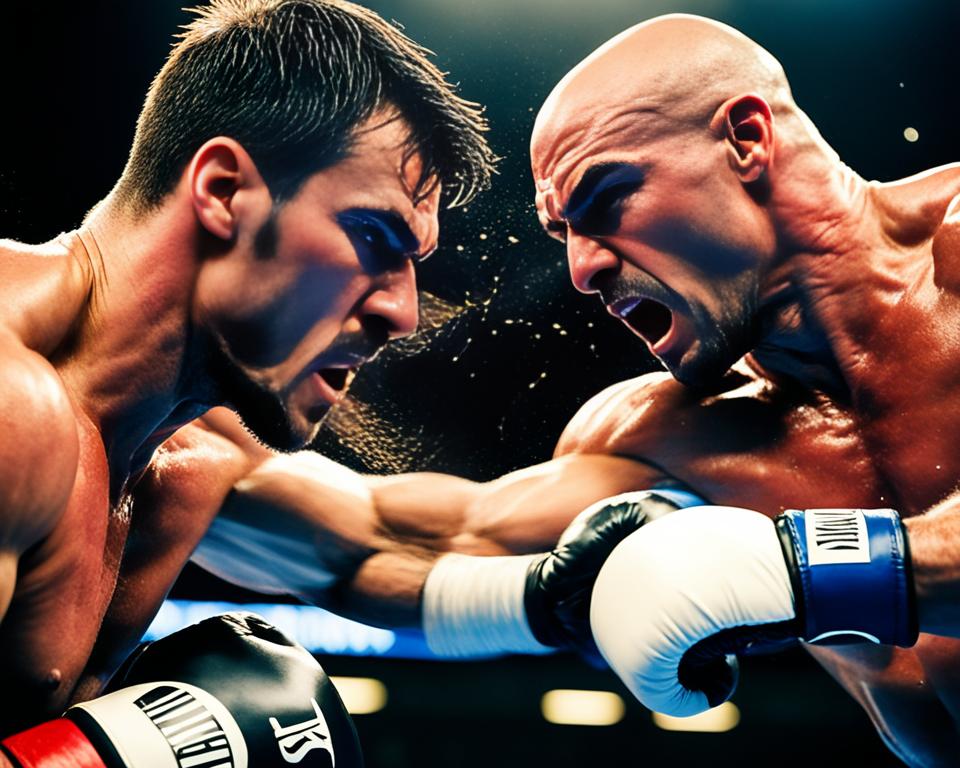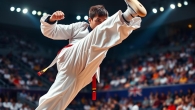
KO Boxing: Knockout Power and Techniques Explained
In the thrilling world of combat sports, knockout boxing stands out. This guide explores the world of KO (knockout) boxing, showing the main techniques. You’ll learn how boxers produce power and use dangerous punches to achieve knockouts. We will cover the science of generating power and the skills needed for deadly hits. It’s a journey to discover how to rule the ring.
Read interesting things at : revolutionbookscamb
Key Takeaways
- Discover the fundamental techniques for generating knockout power in boxing.
- Explore the art of mastering lethal punching combinations, including the devastating straight right and the lethal hook.
- Understand the importance of defensive strategies, footwork, and ring management in KO boxing.
- Learn about the physical and mental conditioning required to build knockout endurance and overcome fear.
- Gain insights into the mechanics and anatomy of knockout punches for optimal power and accuracy.
Introduction to KO Boxing
Knockout (KO) boxing is thrilling and captures fans worldwide. It’s about landing hits that end fights instantly. For boxers and other combat athletes, learning to achieve knockouts is a major goal.
The Art of Knockout Power
Creating knockout power combines strength, skill, and a tough mindset. It’s more than wild punches; true knockout artists know the science behind powerful hits. They use their whole body wisely to deliver stopping blows.
KO boxers focus on leg, core, and upper body strength to hit hard. They start by perfecting essential moves like footwork and punches. This builds the base for their knockout strength.
Understanding Boxing Techniques
- Footwork: Nimble, balanced, and strategically positioned to generate and transfer power.
- Stance: Stable and grounded, with weight distribution that optimizes force delivery.
- Punch Mechanics: Precise timing, body alignment, and explosive hip and shoulder rotation.
- Combination Punching: Stringing together powerful shots to overwhelm and finish opponents.
For KO boxers, mastering these basics is key. They work hard on both technique and staying in top shape. This prepares them to land knockout punches.
In KO boxing, delivering knockout hits is the ultimate achievement. With in-depth knowledge of powerful techniques, fighters reach their full potential. They become known as power punching experts in the combat sports world.
Mastering Knockout Punches
In boxing, a knockout punch is every fighter’s dream. It’s more than just powerful; it can end a fight with a single hit. For those who want to excel in boxing, learning how to execute these strikes is key.
The Devastating Power of the Straight Right
The straight right hand is the most significant punch in boxing. It’s called the “money punch” for a reason. To use it effectively, a boxer must align their body properly, rotate their hips explosively, and move their hand quickly. This combination aims to strike the opponent’s chin or temple with full force. Doing this accurately and at the right moment can result in a knockout.
Unleashing the Hook: A Lethal Combination
The hook punch is also a key technique for a knockout. It has the power to surprise and strike down even strong opponents. The secret is in how a boxer uses their hips and shoulders to build force. When combined with punches like the straight right, it creates a powerful attack.
To perfect knockout punches like the straight right and the hook requires focused training. Boxers must fully grasp the technical aspects of these moves. By doing so, they can achieve consistent knockouts. This, in turn, establishes them as skilled power punchers in the boxing world.
“The ability to land knockout punches is what separates the good boxers from the great ones. It’s a skill that takes time and dedication to perfect, but the rewards are undeniable.”
– Former World Champion Boxer
KO Boxing: The Key to Knockout Success
In combat sports, delivering a knockout blow can change everything. KO boxing stands out in the boxing world as it focuses on ending fights quickly. Elite fighters value the skill of knocking out opponents for its clear win outcomes and thrilling fight style.
The effect of knowing you’re against a knockout boxer is huge. Opponents are more cautious, aware of the immediate threat a single punch poses. This fear may make them more prone to mistakes, creating opportunities for the KO boxer to strike.
But the benefits of KO boxing go beyond the psychological. Skilled KO boxers control the fight’s pace, forcing their opponents into rushed choices. This can ruin an opponent’s plan and lead to an obvious win.
Yet, aiming for knockout success is tough. KO boxers need both strong offense and solid defense. They should be able to handle the comeback attempts of their opponents. Without a complete skill set, including movement and countering, maintaining an advantage in KO boxing is difficult.
Overall, KO boxing is a captivating part of combat sports. Mastering the art brings not just wins but a heightened position in the sport. It’s about knowing not just how to punch hard but also when and where to hit to end a fight.
| Advantages of KO Boxing | Challenges of KO Boxing |
|---|---|
|
|
Learning and carrying out KO boxing can make athletes stand out. It brings an exciting mix of overpowering hits and smart tactics. By mastering it, fighters can rise to the top and earn respect in the fighting community.
Combat Sports Training for Knockout Power
Building knockout power in combat sports needs a wide-ranging training plan. It involves focusing on both physical and technical skills. People dreaming of landing powerful punches should concentrate on gaining strength, doing plyometric exercises, and practicing boxing-specialized routines.
Strength and Conditioning Drills
Creating the ability for knockouts starts with the athlete’s strength and muscle growth. Training should include exercises such as squats, deadlifts, and overhead presses. This helps improve power in the lower body and core, leading to harder strikes.
It’s also important to do plyometric exercises. These include box jumps, medicine ball slams, and explosive push-ups. They work on the fast-twitch muscle fibers, which are key for generating quick, powerful movements in combat sports.
| Exercise | Benefits | Sets x Reps |
|---|---|---|
| Barbell Deadlift | Develops full-body strength, including the posterior chain muscles crucial for powerful punches | 3 x 5 |
| Box Jumps | Improves explosive power and plyometric ability for explosive strikes | 3 x 10 |
| Dumbbell Overhead Press | Strengthens the shoulder muscles for increased striking power | 3 x 8 |
By combining these drills with boxing-specific training, athletes can boost their power. This prepares them to deliver knockout punches.
“Knockout power is not just about muscle mass; it’s about harnessing explosive power, perfect technique, and mental focus. The right training can transform an athlete into a knockout artist.”
Boxing Techniques for Power Punching
Knockout power in boxing isn’t just about being strong. It’s about mastering the right boxing techniques for powerful punches. We’ll look at key techniques to boost your power and land those knockout blows.
The Foundation: Proper Punching Mechanics
To start, you must nail the basic punching moves. Learn the jab, cross, hook, and uppercut well. Focus on keeping the correct form, using your core for force, and sending power through your body in a chain.
- Jab: A quick, straight punch that sets up your combinations and disrupts your opponent’s rhythm.
- Cross: A powerful, straight punch that can be thrown from a solid stance, often following a jab.
- Hook: A looping, short-range punch that delivers devastating power when delivered with proper technique.
- Uppercut: An ascending punch that targets the opponent’s chin, creating openings for follow-up strikes.
Harnessing Hip and Leg Drive
Your lower body is key for power punching. Use your hips and legs to create and send power with each punch.
- Develop a strong, stable stance with a solid base.
- Utilize hip rotation to generate torque and power.
- Coordinate your footwork and leg drive to propel your punches.
Precision and Timing
Knockout blows need more than just strength. They require precise boxing techniques and perfect timing. Sharpen your skills so every punch hits where it should, with maximum impact.
| Technique | Key Aspect | Benefit |
|---|---|---|
| Jab | Precise hand and foot coordination | Disrupts opponent’s rhythm and sets up follow-up punches |
| Cross | Proper weight transfer and hip rotation | Generates maximum power and accuracy |
| Hook | Fluid upper body movement and body positioning | Delivers devastating short-range power |
| Uppercut | Explosive leg drive and proper head movement | Targets the opponent’s chin for a potential knockout |
Power punching combines strength with the right skills and strategy. By learning and perfecting these boxing techniques, you’re on your way to being a stronger, smarter fighter.
Boxing Footwork and Ring Management
In KO boxing, the link between boxing footwork and ring management is crucial. How you move and position yourself can impact the fight greatly. It’s vital for anyone dreaming of being a KO boxer to learn these strategies.
Cutting off the Ring: Tactical Positioning
In KO boxing, mastering cutting off the ring is essential. This means you need to position yourself to control your opponent’s space. You learn how to predict their moves and maintain your dominance. This involves mastering how to shift your weight and strike at the right time.
- Footwork drills to improve agility and lateral movement
- Techniques for closing the distance and cornering your opponent
- Maintaining a balanced, centered stance for optimal power generation
Being a boxing master means you control the fight. You use your skills to make the critical moves that lead to winning. You create chances to land powerful hits, increasing your victory chances.
“Boxing is all about the feet. If you have good feet, you can pretty much do anything.” – Muhammad Ali
It’s about knowing how to position yourself for maximum impact. By learning these combat sports basics, you’re preparing for success in the ring.
Defensive Boxing Strategies
In the world of KO boxing, a strong defense is vital. It’s just as important as knowing how to knock out your opponent with one punch. While hitting hard may be exciting, the real skill in boxing is about avoiding and countering your opponent’s attacks. We will explore key defensive moves all KO boxers should learn to land powerful counterattacks.
Slip, Parry, and Counter: Evading Strikes
Defensive boxing is based on three main ideas: slip, parry, and counter. These methods help keep the KO boxer safe and create chances to strike back hard.
Slipping means moving your body out of the way of a punch just in time. It looks simple but requires perfect timing and footwork. This way, the boxer can dodge an attack without losing their own attacking position.
Parrying is about blocking a punch with a well-timed hand movement. It shifts the attack’s direction and sets up an opening for a strong counterpunch. This skill demands sharp eyes, quick reflexes, and a solid grasp of boxing fundamentals.
The main aim of a defensive boxer is to turn the opponent’s strength against them. If a punch is slipped or parried, the boxer has an instant to respond with a counterpunch. This hits the opponent when they’re not ready and might end the fight then and there.
Learning to slip, parry, and counter marks a significant step in a boxer’s journey. It means they can stay cool, save energy, and find the perfect moment to launch their winning strikes.
“The best defense is a good offense, but the surest defense is a great defense.” – Unknown
Building Knockout Endurance
In boxing conditioning and combat sports training, having great endurance is vital for any KO boxer. Staying strong through boxing drills and exercises is key. This lets them throw powerful, fight-ending punches.
For knockout power, training your heart and muscles is crucial. Workout like jumping rope, sprints, and burpees mixes up fast and steady activities. It gets your body ready for the tough physical challenges of a match.
Muscle power is also needed for hard hits. Doing plyometric pushups, squat jumps, and medicine ball throws boosts your explosive strength. This helps turn your punches into heavy blows.
Rest and recovery are as important as training. Eating well, drinking enough water, and sleeping help your body fix and recharge. Adding easy exercises and foam rolling can keep you strong between hard training days.
Learning boxing conditioning is how KO boxers keep up their power during fights. This raises their chances of hitting a winning blow when it counts most.
| Exercise | Benefits | Duration/Reps |
|---|---|---|
| Jumping Rope | Improves cardiovascular fitness, coordination, and footwork | 3-5 minutes, 1-2 sets |
| Sprints | Develops explosive power and anaerobic capacity | 30-60 seconds, 5-8 reps |
| Burpees | Engages multiple muscle groups and elevates heart rate | 10-15 reps, 2-3 sets |
| Plyometric Pushups | Builds upper body power and explosive strength | 8-10 reps, 3 sets |
| Squat Jumps | Develops lower body power and explosiveness | 12-15 reps, 2-3 sets |
| Medicine Ball Throws | Improves full-body power and punching force | 8-10 reps, 3 sets |
“The true essence of a champion is not the victory, but the journey. It’s about pushing yourself to the limits and finding that extra bit of strength, speed, and endurance when you need it most.”
Mental Toughness in KO Boxing
Knockout boxing (KO boxing) is more than just being strong. It also needs strong mental toughness. Getting the right mindset is key for boxing. It helps fighters beat fear, keep focused, and make big hits even when it’s hard.
Overcoming Fear and Staying Focused
Fear is normal in combat sports. But, top KO boxers face it and win. They train hard and work on their minds to be strong. This keeps them calm and focused even when things are tough.
- Visualization techniques: Seeing good results and imagining perfect knockouts boost confidence and lower stress.
- Controlled breathing: Breathing exercises calm the nerves and help in staying focused during the action.
- Mindfulness practices: Meditation sharpens focus, control over emotions, and rock-solid decision-making when under stress.
With these mental tools, KO boxers keep cool and make accurate moves, even in the toughest fights.
“The will to win is nothing without the will to prepare.” – Juma Saidi, world-renowned combat sports training expert
Staying mentally sharp is key to land big hits regularly. KO boxers who are experts at mental strength and training rise to the sport’s top.

Knockout Punches: Anatomy and Mechanics
In combat sports, understanding the punch that knocks out your opponent is vital. These sports use the ground’s force through your body, hitting with powerful punches. Let’s look into why these strikes are so powerful and how they work.
The Kinetic Chain in Action
A knockout punch isn’t just about being strong. It’s about using your whole body efficiently. This is called the kinetic chain. It means different muscles work together to create power.
- It starts with the ground, using your back foot and hip movement to begin the punch.
- The power goes through your core, twisting your torso and adding more strength.
- Finally, your upper body moves, sending your arm flying with intense speed and force.
Learning and perfecting this chain is how fighters become better at knockout punches.
Muscle Groups and Joint Mechanics
Powerful punches rely on many muscles working together. Key muscles include:
- Quadriceps and glutes for pushing off the ground
- Core muscles for balance and twisting force
- Arm muscles for extending your punch with power
Tapping into these muscle groups, while moving your body correctly, is key for maximum impact. Good form, like proper hip and shoulder movement, boosts the power of your punch.
Knowing the science of knockout punches helps athletes get stronger and more precise. It’s about the right strength, coordination, and form. Mastering these skills leads to greater success in the ring or octagon.
Boxing Drills and Exercises
Boxers looking to pack a punch need a solid plan. This plan focuses on creating speed, power, and accuracy. They mix up boxing drills and exercises to get better. This way, fighters learn to hit hard, fast, and win fights.
Developing Speed, Power, and Accuracy
Learning power punching techniques takes lots of different training. This includes hitting the bag hard and practicing moves without a partner. By doing these and other drills, fighters get stronger and better at their skills.
- Plyometric Exercises: Things like box jumps and burpees help with quick and powerful punches. They make your muscles work fast.
- Partner Drills: Working with someone on moves and blocking helps fighters get in better shape and react faster.
- Resistance Training: Lifting weights like squats and deadlifts build a strong base for knockout punches.
By using these boxing drills and exercises, fighters can find their true power. They get ready to face any opponent with confidence in their strength.
“The key to knockout success lies in the relentless pursuit of speed, power, and accuracy – the cornerstones of the KO boxer’s arsenal.”
If boxers keep training hard and smart, they become skilled at ending fights. With the right mix of moves and power, they can win any challenge.
Legendary KO Boxers and Their Techniques
In ko boxing, some fighters stand above all, defining the sport with their knockout skills. These are the legendary KO boxers. They have amazed fans globally with their power and effective combat sports training.
Mike Tyson is one famous figure. He used the peek-a-boo style. This tactic let him avoid hits, then strike quickly with powerful combos. He was known for his explosive knockout punches.
“I’m going to hit him so hard, he’s going to wish he’d never been born.”- Mike Tyson
Then we have Manny Pacquiao. His speed and timing set him apart. Pacquiao could attack and defend flawlessly. His unmatched training made him overwhelm foes with his punches.
| Legendary KO Boxer | Signature Technique | Impact on the Sport |
|---|---|---|
| Mike Tyson | Peek-a-Boo Style | Revolutionized the art of aggressive, power-based boxing |
| Manny Pacquiao | Combination Punching and Footwork | Demonstrated the importance of speed, timing, and conditioning in knockout success |
| George Foreman | Powerful Straight Right Hand | Epitomized the devastating impact of the “one-punch knockout” |
George Foreman was another force. He was known for his heavy straight right hand. His power and accuracy in that punch made him a feared challenger. Many remember him for his knockout power.
These great KO boxers have changed the sport forever. They inspire new fighters to explore the limits of power and combat sports training. Their impact in ko boxing is unforgettable.

Boxing Equipment for Knockout Training
For KO boxers aiming to build knockout power, the right gear is key. It enhances their training and boosts progress. From combat sports to boxing drills, the correct equipment offers support. It also protects them, helping improve their skills.
It’s essential for boxers to invest in top-notch gloves, handwraps, and mouthguards. These items protect against injury and boost each strike’s power. Training tools like heavy bags, speed bags, and focus mitts are just as important. They help boxers perfect their punches and increase their stamina for achieving knockouts.
Choosing the right boxing gear is crucial for KO boxers. It helps them develop technically, stay physically fit, and mentally strong. With the best equipment, they can chase their knockout goals. It allows them to elevate their boxing capabilities.









Leave a Reply